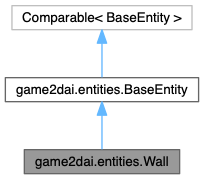
Public Member Functions | |
| Wall (Vector2D start, Vector2D end, boolean visible) | |
| Wall (String name, Vector2D start, Vector2D end, boolean visible) | |
| Vector2D | getStartPos () |
| Vector2D | getEndPos () |
| Vector2D | norm () |
| boolean | isEitherSide (double x0, double y0, double x1, double y1) |
| boolean | isInDomain (Domain view) |
| boolean | isOver (double px, double py) |
 Public Member Functions inherited from game2dai.entities.BaseEntity Public Member Functions inherited from game2dai.entities.BaseEntity | |
| BaseEntity () | |
| BaseEntity (String name) | |
| BaseEntity (String entityName, Vector2D entityPos, double entityColRadius) | |
| int | ID () |
| void | updateFSM (double deltaTime, World world) |
| FiniteStateMachine | FSM () |
| boolean | hasFSM () |
| void | addFSM () |
| boolean | removeFSM () |
| int | Z () |
| BaseEntity | Z (int z) |
| boolean | isVisible () |
| BaseEntity | visible (boolean visible) |
| double | colRadius () |
| BaseEntity | colRadius (double colRadius) |
| boolean | isOverLapAllowed () |
| BaseEntity | overLapAllowed (boolean overLapAllowed) |
| boolean | isInDomain (Domain view) |
| boolean | isOver (double px, double py) |
| BaseEntity | renderer (Picture renderer) |
| Picture | renderer () |
| void | die (World world, double timeToLive) |
| void | born (World world, double timeToLive) |
| BaseEntity | moveTo (double x, double y) |
| BaseEntity | moveTo (Vector2D p) |
| BaseEntity | moveBy (double x, double y) |
| BaseEntity | moveBy (Vector2D p) |
| Vector2D | pos () |
| BaseEntity | name (String name) |
| String | name () |
| boolean | isEitherSide (double x0, double y0, double x1, double y1) |
| boolean | isEitherSide (Vector2D p0, Vector2D p1) |
| void | update (double deltaTime, World world) |
| void | draw (World world) |
| void | draw (double elapsedTime, World world) |
| int | compareTo (BaseEntity o) |
| String | toString () |
Package Attributes | |
| Vector2D | end = new Vector2D() |
| Vector2D | wallNorm |
 Package Attributes inherited from game2dai.entities.BaseEntity Package Attributes inherited from game2dai.entities.BaseEntity | |
| boolean | overlapAllowed = false |
Additional Inherited Members | |
 Public Attributes inherited from game2dai.entities.BaseEntity Public Attributes inherited from game2dai.entities.BaseEntity | |
| String | tag = "" |
| int | tagNo = 0 |
 Protected Attributes inherited from game2dai.entities.BaseEntity Protected Attributes inherited from game2dai.entities.BaseEntity | |
| Integer | entityID |
| String | name = "" |
| Picture | renderer = null |
| boolean | visible = true |
| Vector2D | pos = new Vector2D() |
| double | colRadius |
Detailed Description
This class represents a wall.
A wall is used to constrain the movement of Vehicle entities that are using 'wall avoidance' in their steering behaviour. A vehicle will not pass through a wall from the 'outside' but will pass through from the inside (i.e. a one-way wall!).
If you image the wall to be the radius of a circle with the wall start position at the centre and the end position on the circumference, then the clockwise side is considered to be the 'outside' and the anti-clockwise side the 'inside'. So be careful which way you define the wall end-points.
Constructor & Destructor Documentation
◆ Wall() [1/2]
Create a wall.
- Parameters
-
start wall start position. end wall end position visible whether the wall is visible
◆ Wall() [2/2]
Create a 'named' wall.
- Parameters
-
name the name you want to give this entity start wall start position. end wall end position visible whether the wall is visible
Member Function Documentation
◆ getEndPos()
| Vector2D game2dai.entities.Wall.getEndPos | ( | ) |
Get the world end position
◆ getStartPos()
| Vector2D game2dai.entities.Wall.getStartPos | ( | ) |
Get the wall start position
◆ isEitherSide()
| boolean game2dai.entities.Wall.isEitherSide | ( | double | x0, |
| double | y0, | ||
| double | x1, | ||
| double | y1 | ||
| ) |
Determines whether the two points given are 'either side of the object' if true then the two positions are not visible to each other.
- Parameters
-
x0 first point x position y0 first point y position x1 second point x position y1 second point y position
- Returns
- true if the points are on opposites sides of the wall
Reimplemented from game2dai.entities.BaseEntity.
◆ isInDomain()
| boolean game2dai.entities.Wall.isInDomain | ( | Domain | view | ) |
Determine whether this entity is inside or part inside the domain. This method is used by the world draw method to see if this entity should be drawn.
- Parameters
-
view the world domain
- Returns
- true if any part of this entity is inside the domain
Reimplemented from game2dai.entities.BaseEntity.
◆ isOver()
| boolean game2dai.entities.Wall.isOver | ( | double | px, |
| double | py | ||
| ) |
Since the wall is considered to have no thickness then the world point cannot be over the wall. So this always returns false;
Reimplemented from game2dai.entities.BaseEntity.
◆ norm()
| Vector2D game2dai.entities.Wall.norm | ( | ) |
Get the wall normal - it will point 'outside'
- Returns
- the wall normal (always in normalised form)
The documentation for this class was generated from the following file:
- /Users/peter/git/ai4games-repos/AI_4_2D_Games/src/game2dai/entities/Wall.java